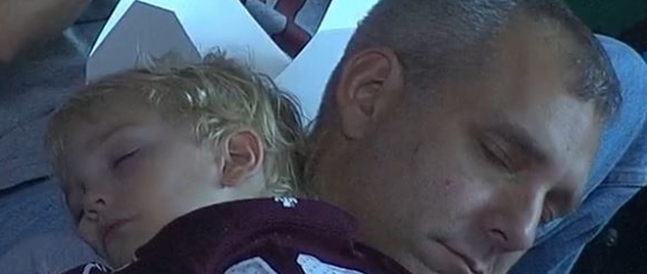Nap Time!
For how much I have written about trying to sit with whatever is happening in Touch Practice, not having a directed outcome, trying not to get attached to any one experience in particular, I guess it’s just a tiny bit hypocritical for me to write what I’m about to write next. But one of my very favorite moments in Touch Practice occurs when someone falls completely asleep on me, dozing off into a deep snore while I’m holding them. I love it when that happens.
 I am at a point in my practice where I can often sense when that is about to happen, and I have learned how to invite and support sleep for a brief period, as well as how to gently bring someone out of a sleep so that they don’t even realize they were sleeping. Today I want to write a little bit about the mechanics of getting people in and out of sleep safely and comfortably. This will be a little bit more of a technical blog, intended for those of you who’ve been to workshops or done individual work with me. However, there are hundreds of you at this point, and I think this information will be useful to those of you who are out there practicing.
I am at a point in my practice where I can often sense when that is about to happen, and I have learned how to invite and support sleep for a brief period, as well as how to gently bring someone out of a sleep so that they don’t even realize they were sleeping. Today I want to write a little bit about the mechanics of getting people in and out of sleep safely and comfortably. This will be a little bit more of a technical blog, intended for those of you who’ve been to workshops or done individual work with me. However, there are hundreds of you at this point, and I think this information will be useful to those of you who are out there practicing.
The type of touching that we use in Touch Practice varies almost infinitely, and we could describe and classify things many different ways. For simplicity, though, I think one could categorize all the different forms of touch in one of two ways, either yang-style touch or yin-style touch. Yin and Yang are complicated concepts and you can read about them more in depth here. For our simple purposes, consider the sun and the moon. The way the sun produces light through an active, productive process is a good example of yang energy. The way the moon produces light, through passive, reflective processes, is a good example of yin.
 In Touch Practice, there will often be quite a bit of yang energy at the beginning of a practice. There is a kind of active electricity the first time two bodies come together; the type of touch often involves long, slow strokes of the body, or curious exploration as the hands familiarize themselves with the landscape of the body. There may be erotic arousal with or without erection, and we direct our attention in this phase to establishing grounding through active breathing and energetic proprioception, actively exploring the map of the energetic body.
In Touch Practice, there will often be quite a bit of yang energy at the beginning of a practice. There is a kind of active electricity the first time two bodies come together; the type of touch often involves long, slow strokes of the body, or curious exploration as the hands familiarize themselves with the landscape of the body. There may be erotic arousal with or without erection, and we direct our attention in this phase to establishing grounding through active breathing and energetic proprioception, actively exploring the map of the energetic body.
The “wipe” that many of you understand from Touch Practice is yang-style touch. Yang style touch tends to raise energy in the body. It will engage erotic energy if it is there (or engage fear, or curiosity, or joy, or anything else the partners happen to be experiencing.)
Those of you who have done workshops or individual work will recall that from time to time (every few minutes, actually) during this phase of the work, I will often cue, “now just rest.” I may invite you to just stand in your feet and take a couple breaths. Like punctuation on the end of a sentence, the breath with “now just rest” is necessary during the yang phase of the work.

As we move, in a classic Touch Practice pattern, from approach, to standing hug, to sitting work, to horizontal posture, we begin to exhaust the yang exploration–the partners eventually feel like their curiosity about the other body has been satisfied, and the energy begins to move towards a more calm, reflective energy–the yin postures become more useful.
Those of you who remember “frog,” where my partner is lying on top of me, face down, belly to belly, with his head resting on my shoulder and legs slightly froggy supported by my legs, have a good example of a yin pose. The partners simply rest there; there is no work to do, no exploration. (Sometimes younger, inexperienced partners will get into “Frog” with grinding of the hips and gyrations, and that’s not at all the point of that pose. I have to gently calm them down and move them from a yang framework to understand the power of the yin pose.)
It is as we explore, and get further into, the yin set of poses (frog, boa constrictor, turtle, and side-snuggle) that the desire for the body to sleep will show itself if it is present. It’s not something that should be forced or manipulated, but it is something that you can watch for, and facilitate if it surfaces.
The prime signal that the body would like some sleep time is something called a presomnial twitch or hypnagogic jerk. No, it’s not an insult; I’ve held many very lovable hypnagogic jerks.
What happens is that just before the body goes to sleep, in the state in between awakeness and sleep, the muscles will twitch, often very, very faintly, like those little “daily earthquakes” you are aware of if you’ve lived in Southern California–constant but barely perceptible. If you’re holding someone or they are lying on your chest, you can feel dozens of these twitches if a person is in state of pre-sleep. Apply a yin-style touch–such as wrapping your arms around them very carefully, squeezing with a moderate but constant pressure, and just hold them very still, very calmly–and if sleep is going to happen, it will happen at that moment.
 What we are doing, in a way, is imitating the practice of swaddling a baby. Babies sleep better when they are “held” fairly tightly in a blanket because it helps keep them from waking themselves with their own twitches. The arms of the holder reproduce that swaddling environment for the adult, who may be in various parts of his body (child or infant) during the phases of Touch Practice.
What we are doing, in a way, is imitating the practice of swaddling a baby. Babies sleep better when they are “held” fairly tightly in a blanket because it helps keep them from waking themselves with their own twitches. The arms of the holder reproduce that swaddling environment for the adult, who may be in various parts of his body (child or infant) during the phases of Touch Practice.
The horizontal poses (frog, boa constrictor, turtle) have to be really carefully balanced and properly prepared, with the partner’s head well supported, because when sleep happens, the balance of the body can shift suddenly and dramatically, and the last thing we want to do is drop the baby.
I will normally let my partner sleep for about ten minutes, just holding him very still and constant during that period. Whatever inner work needs to occur will occur by itself, and sometimes the body itself will cue when this work is finished, either by a change in breathing or by some sort of happy groan or vocalization.
When you’re ready to assist your partner in emerging from sleep, apply very gradual, very gentle increasing yang energy–perhaps the hands up and down the back, or gently kneading the shoulders, or running along the arms, and the body will slowly return to an awakened state. Very often people do not realize they were sleeping, and very often there’s not really any reason they need to know. The body takes care of what it needs if we simply support it.
I have learned to trust the periods of sleep that occur in Touch Practice as well-deserved rest points, but also places where Spirit can move deeply, invisibly, and privately to care for the person we have in our arms. All we have to do is keep the container; the contents are taken care of for us.
Have thoughts you’d like to share?
Touch Practice is a sacred practice for me, and part of that is keeping confidences sacred. While a name and e-mail address are required to post a comment, feel free to use just your first name, or a pseudonym if you wish. Your e-mail address will never be seen by or shared with anyone. It is used to prevent spam and inappropriate comments from appearing in the blog. I’d really like to hear from you!














Kevin,
Okay I’m ready ! As I wrote those words I had to stop, and just “Be”. To let the emotion flow through my body, mind, and spirit. This practice is so beautiful and touching, you and the others who get to experience this are extremely blessed.
I had Be in the moment, because I am so lacking in “touch” ! I have been the primary caregiver for my Mother for almost two years, giving to someone else in such a manner, without receiving touch and or much communication makes a person long for the reassurance of personal touch.
Your blog has touched that “need” awakened me to what I have been missing. I had considered getting a massage in the past week for just that reason. To be touched, gently and caringly.
Thank you Kevin !
Jeff, so happy to have your message! I have had more than one person come to Touch Practice, individually or by workshop, who identified as a primary caregiver for a family member. Those who are givers often have the gift of being able to devote themselves to nourishing others, but sometimes we can start to get quite hungry ourselves, often without noticing! I’m happy to hear that you’re taking care of yourself too, and I wish you the very best in finding the touch that is right for you. My prayer for you is that you’ll get exactly what you need and that someone else will show up to care for you. Warm hugs–Kevin